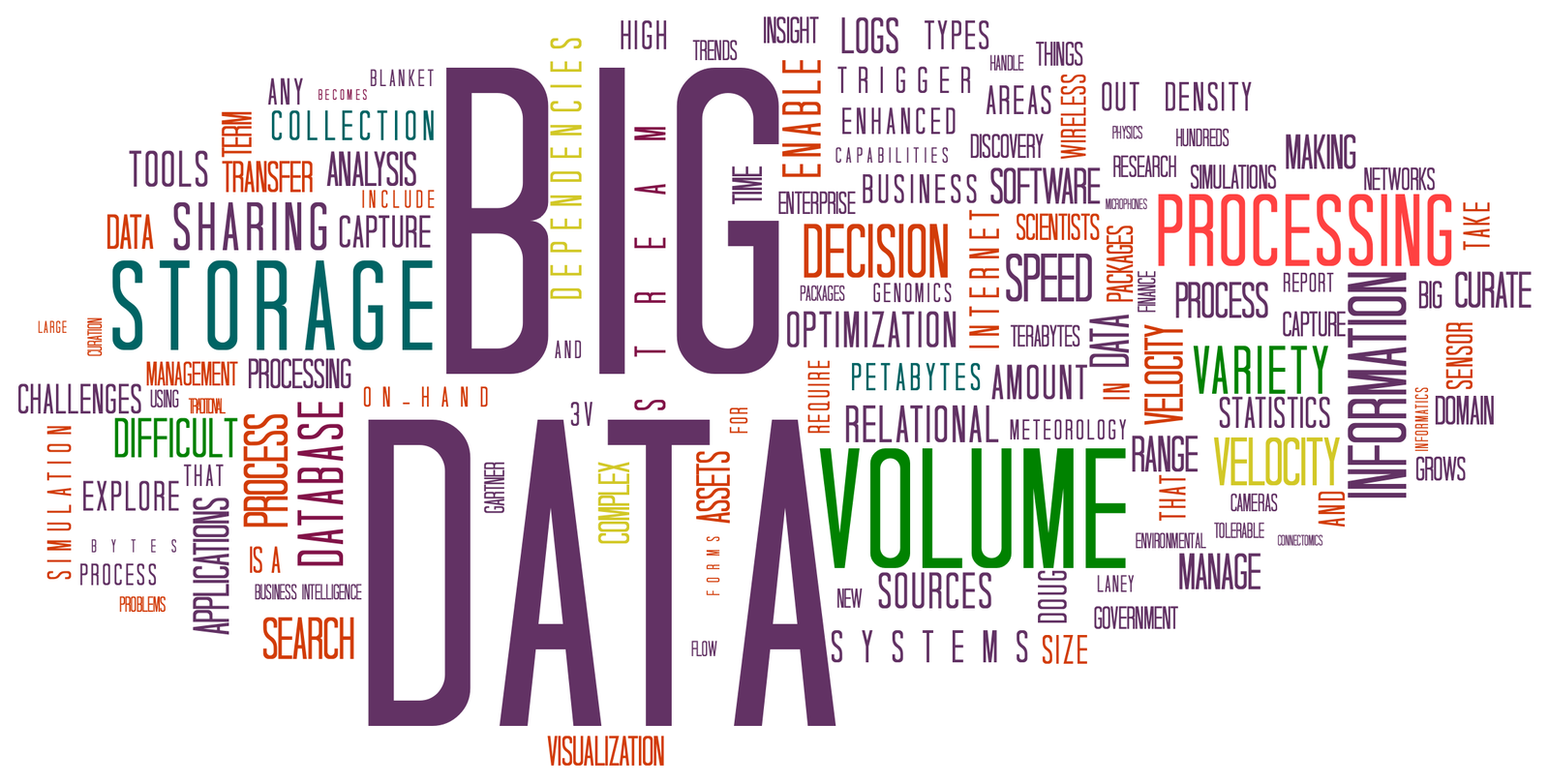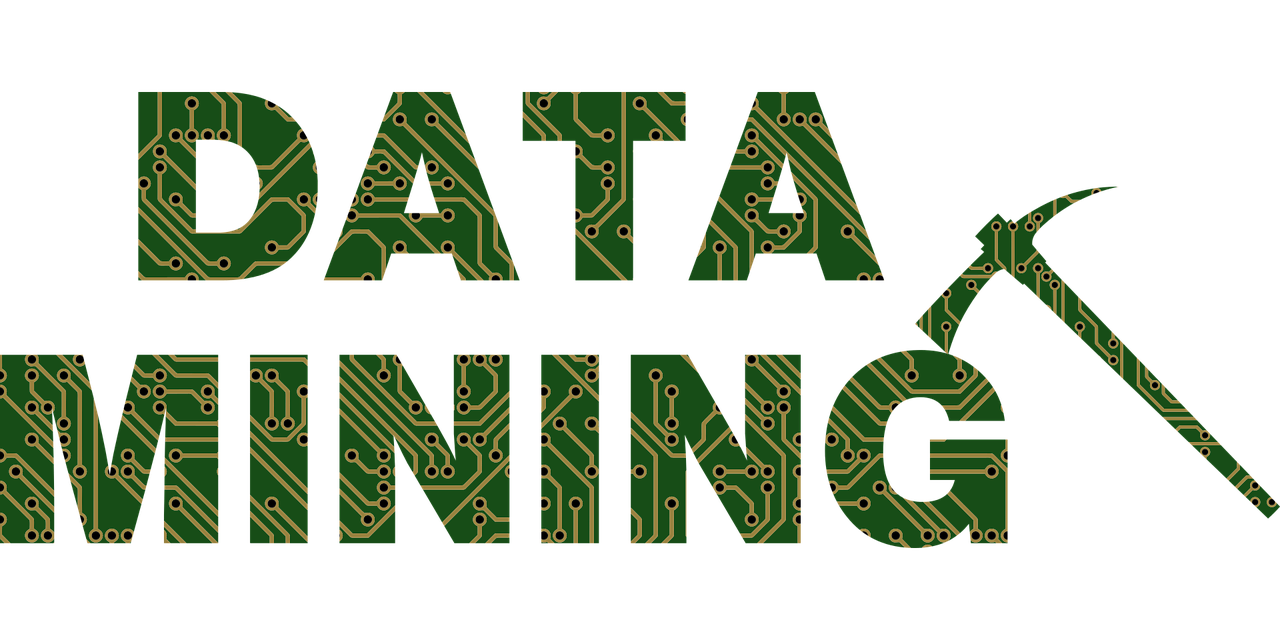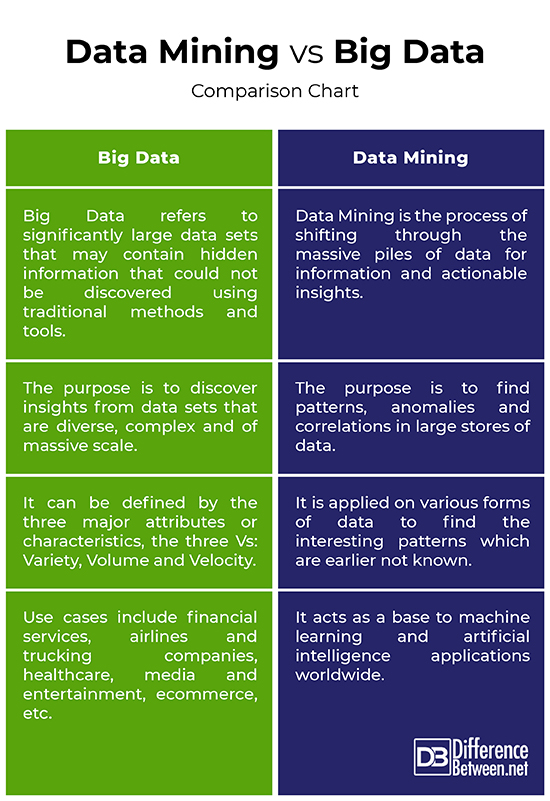Difference Between Data Mining and Big Data
We live in a world where insane amounts of data are collected on a daily basis. For example, around 48 hours of videos are uploaded to YouTube every minute. But it’s not the amount of data that matters; it’s what organizations and businesses do with the data that matters. Storing and processing the data becomes a challenging task, as data grows rapidly. From a business perspective, data is king. And analytics is the new “Queen of Sciences.” Data mining is a tool to discover knowledge from data.

What is Big Data?
Big Data previously meant unstructured chunks of data mined or generated from the Internet on petabytes scale. Actually, the term ‘Big Data’ in its current form appears to have been first used in the late 1990s and the first academic paper was published in 2003 by Francis X. Diebolt – “Big Data Dynamic Factor Models for Macroeconomic Measurement and Forecasting.” The big data era is recognized by rapidly expanding volumes of data, far beyond what most people imagined would ever occur. Before the big data era began, organizations assigned relatively low value to the data. But with the explosion of data, this investment in collecting and storing data for its potential future value have changed. Currently 90% of the big data is known to have accumulated in the last couple of years alone. Numerous technological innovation and increasing use of smartphones are driving the dramatic surge in data. So simply put, big data reflects the rapidly changing world we live in.

What is Data Mining?
Now that we are in the big data era, the biggest challenge is not getting data but getting the right data and using computers to augment our knowledge and identify patterns that we could not identify previously. Data in its raw form has no value. The rate of accumulation of data is rising faster than our capacity to analyze and process such large data sets in order to make decisions. Terabytes or petabytes of data pour into our computer networks every second. Powerful and versatile tools are required to automatically filter through the tremendous amounts of data and discover valuable information, and finally transform those data into organized knowledge. This necessity has led to the birth of data mining. So, data mining is turning data into knowledge. Data mining attempts to find relationships and associations between data elements that are not found before. It is the process of finding patterns, anomalies and correlations in large stores of data and turning those data into actionable knowledge.
Difference between Data Mining and Big Data
Definition
– Big Data is an all-inclusive term that refers to the collection and subsequent analysis of significantly large data sets that may contain hidden information or insights that could not be discovered using traditional methods and tools. The amount of data is quite a lot for traditional computing systems to handle and analyze.
Data Mining is the process of shifting through the massive piles of data for information and actionable insights. It is the process of finding patterns, anomalies and correlations in large stores of data and turning those raw data into organized knowledge.
Purpose
– Big Data refers to the use of predictive analytics, user behavior analytics, or other data analytics methods to extract value from data with sizes beyond the capability of commonly used software tools to capture, manage, and process. The purpose is to discover insights from data sets that are diverse, complex and of massive scale.
Data mining attempts to find relationships and associations between data elements that are not found before. Data mining is knowledge mining and how to utilize the raw data to generate some sort of a knowledge which can be used for decision making. It attempts to find hidden patters from already available data.
Characteristics
– Big Data can be defined by the three major attributes or characteristics, the three Vs: Variety, Volume and Velocity. These are key to understanding how we can measure big data. Variety refers to the various data types, such as structured, semi-structured and unstructured data; Volume refers to the massive amounts of data generated; and Velocity refers to the speed at which the data is generated.
Data mining is similar to searching, but it’s not searching or querying the data; it is applied on various forms of data to find the interesting patterns rather than results from database.
Use Cases
– Various fields in today’s day-to-day life are using big data to ease the process of storing and processing the data. The many examples of big data use cases include financial services, airlines and trucking companies, healthcare sector, telecommunications and utilities, media and entertainment, ecommerce, education, IoT, etc.
Applications of data mining are wise and diverse. Some basic applications include product recommendations in ecommerce, web page analysis, stock market predictions, healthcare data mining, and so on. Data mining is a base to machine learning and AI applications worldwide.
Data Mining vs. Big Data: Comparison Chart

Summary of Data Mining and Big Data
Big Data refers to large data sets that may contain hidden information or insights that could not be discovered using traditional methods and tools. The amount of data is quite a lot for traditional computing systems to handle and analyze. Data mining is turning raw data into knowledge because data in its raw form has no value. Data mining attempts to find relationships and associations between data elements which can be used to make effective decision making.
- Difference Between Caucus and Primary - June 18, 2024
- Difference Between PPO and POS - May 30, 2024
- Difference Between RFID and NFC - May 28, 2024
Search DifferenceBetween.net :
Leave a Response
References :
[0]Ghavami, Peter. Big Data Analytics Methods: Analytics Techniques in Data Mining, Deep Learning and Natural Language Processing. Berlin, Germany: Walter de Gruyter, 2019. Print
[1]Ghavami, Peter. Big Data Analytics Methods: Analytics Techniques in Data Mining, Deep Learning and Natural Language Processing. Berlin, Germany: Walter de Gruyter, 2019. Print
[2]Dean, Jared. Big Data, Data Mining, and Machine Learning: Value Creation for Business Leaders and Practitioners. New Jersey, United States: John Wiley & Sons, 2014. Print
[3]Han, Jiawei et al. Data Mining: Concepts and Techniques. Amsterdam, Netherlands: Elsevier, 2011. Print
[4]Zaki, Mohammed J. and Wagner Meira. Data Mining and Analysis: Fundamental Concepts and Algorithms. Cambridge, United Kingdom: Cambridge University Press, 2014. Print
[5]Image credit: https://commons.wikimedia.org/wiki/File:BigData_2267x1146_white.png
[6]Image credit: https://pixabay.com/da/vectors/en-jeg-ai-anatomi-2729773/
